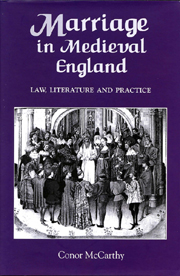2 - Marriage and Property
Published online by Cambridge University Press: 12 September 2012
Summary
Although the Church in the later Middle Ages promoted marriage first and foremost as a consensual commitment between two individuals, marriage always had implications for the transfer of property between kin. Major redistribution of property within families tends to take place on two occasions – at the death or marriage of a family member. Along with inheritance strategies, marriages were the major means by which families sought to establish economic viability for the succeeding generation. Marriages, then, were occasions on which property transfers, both symbolic and real, took place within and between families.
What this meant in practice was that it was difficult to get married without access to sufficient property to establish an economically viable family unit. The question of who gives property to the married couple and their heirs, or how it is held by them, varied across medieval Europe: we find that brides bring dotal payments to their husbands in Roman society, followed by a reversal of direction in the late empire which persists throughout the earlier part of the Middle Ages, until there is once again a shift back to dowries given by the bride's family in the central and later Middle Ages. But at all times and all social levels property is required in order to get married and establish some sort of household. George C. Homans argues on the basis of linguistic evidence that the landless were unable to marry. Anilepiman meant both ‘single man’ and ‘landless man,’ and husbond meant both ‘husband’ and, in northern and eastern England, the holder of a certain sort of (quite substantial) tenement.
- Type
- Chapter
- Information
- Marriage in Medieval EnglandLaw, Literature and Practice, pp. 51 - 77Publisher: Boydell & BrewerPrint publication year: 2004



